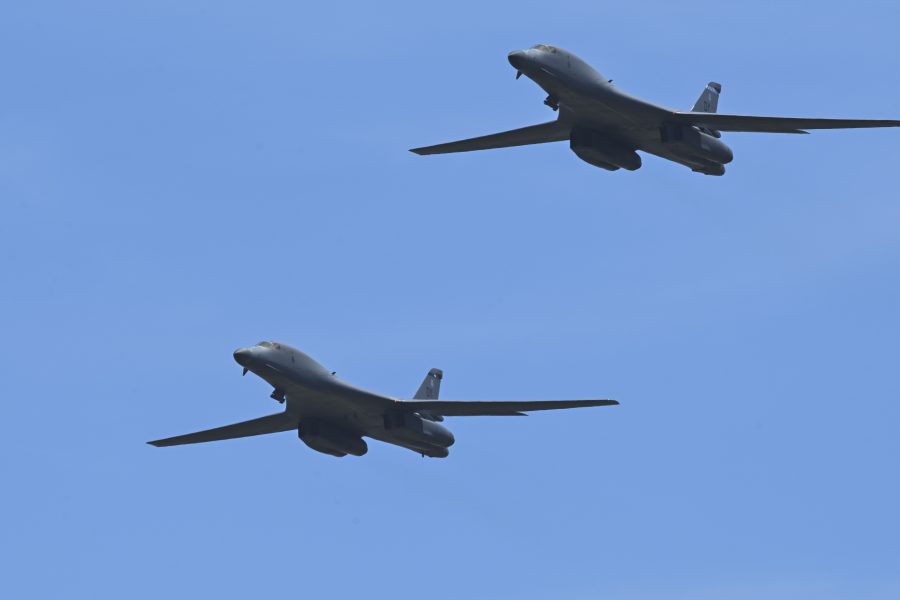The Pentagon is significantly bolstering airpower near Venezuela, dispatching the USS Gerald R. Ford Carrier Strike Group to Latin America, it said in an Oct. 24 statement.
The announcement came just hours after U.S. Air Force B-1 bombers and other U.S. assets flew near the Venezuelan coast on Oct. 23. Earlier in the day on Oct. 24, Secretary of Defense Pete Hegseth announced the U.S. military conducted its 10th lethal airstrike on alleged drug smugglers in the overnight hours.
The military operations are part of a broader pressure campaign on drug cartels and the regime of Venezuelan President Nicolas Maduro, whom the White House says is an illegitimate leader who should leave his post. President Donald Trump has said on multiple occasions, most recently on Oct. 23, that the U.S. may strike targets on land.
“In support of the President’s directive to dismantle Transnational Criminal Organizations (TCOs) and counter narco-terrorism in defense of the Homeland, the Secretary of War has directed the Gerald R. Ford Carrier Strike Group and embarked carrier air wing to the U.S. Southern Command (USSOUTHCOM) area of responsibility,” Sean Parnell, the top Pentagon spokesperson, said in a statement, referring to Hegseth by his secondary title authorized by the Trump administration.
Hegseth’s order to dispatch the Ford, the world’s largest aircraft carrier, is a significant escalation of the U.S. growing military presence in the Caribbean. The carrier’s embarked combat aircraft comprise Carrier Air Wing Eight—which includes multiple F/A-18 Super Hornet fighter jet squadrons, a squadron of EA-18 electronic warfare attack planes, and other support aircraft and helicopters. The carrier’s battlegroup also includes several Tomahawk cruise-missile carrying destroyers. The Ford was last known to be in port in Croatia and will take a number of days to transit the Atlantic.
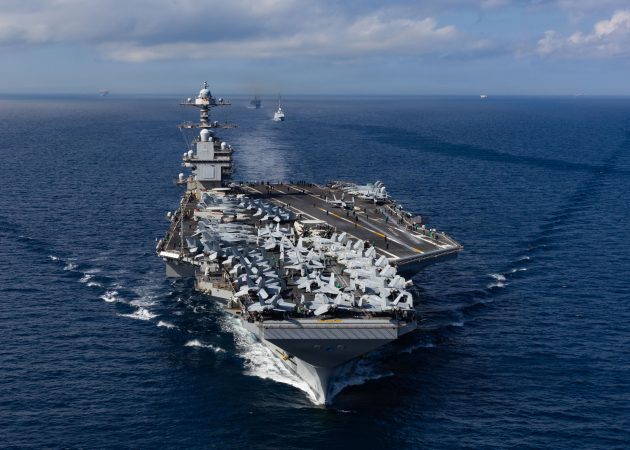
“The enhanced U.S. force presence in the USSOUTHCOM AOR will bolster U.S. capacity to detect, monitor, and disrupt illicit actors and activities that compromise the safety and prosperity of the United States homeland and our security in the Western Hemisphere. These forces will enhance and augment existing capabilities to disrupt narcotics trafficking and degrade and dismantle TCOs,” Parnell added.
The announcement of the carrier strike group deployment came just hours after the latest deadly strike on a boat and a flight of Air Force bombers to the region.
On Oct. 23, the two B-1B Lancers, which can carry standoff cruise missiles, flew near Venezuela after taking off from Dyess Air Force Base, Texas, according to U.S. officials and open-source flight tracking data.
A week earlier, three B-52H Stratofortress bombers from the 2nd Bomb Wing at Barksdale Air Force Base. La., joined armed Marine Corps F-35B stealth fighters, 10 of which are based in Puerto Rico, in what the U.S. military referred to as “bomber attack demonstration,” in which the planes conducted orbits off the Venezuelan coast for hours.
The B-1s used the callsigns BARB21 and BARB22 and had their transponders on, flight tracking data shows. U.S. officials also confirmed the flight. As in the previous flight of B-52s, photos of which were later published by the U.S. military, the active transponders indicated the bombers did not attempt to hide their presence. The bombers flew roughly 50 miles off the coast of Venezuela.
A U.S. Air Force RC-135 signals intelligence aircraft was also in the area at the time, according to open-source analysis of air traffic control radio transmissions. The U.S. military did not confirm the presence of an RC-135, standard practice with intelligence-gathering aircraft. But the U.S. Navy already has a publicly acknowledged surveillance plane presence in the region, with multiple P-8 Poseidon reconnaissance and maritime patrol planes operating out of Puerto Rico.
The U.S. also deployed an E-11 BACN, a communications relay aircraft, from its home base of Warner Robins, Ga., to San Juan, Puerto Rico, on Oct. 23, flight tracking data shows. The E-11 returned home the same day.
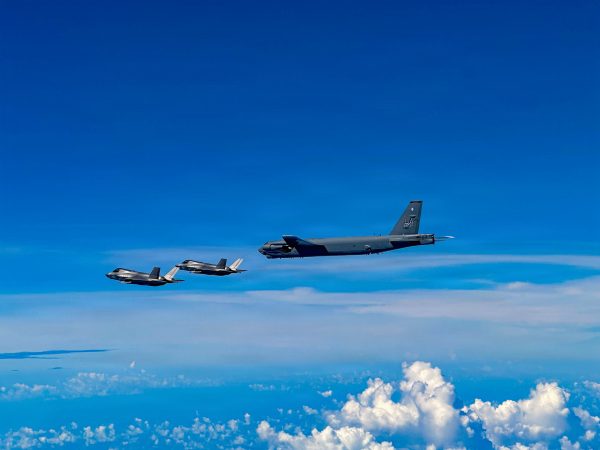
“I’m not going to necessarily ask for a declaration of war,” Trump said Oct. 23. “People that are bringing drugs into our country … we’re going to kill them. You know, they’re going to be, like, dead.
“The land is going to be next,” Trump added. “And we may go to the Senate; we may go to the Congress and tell them about it, but I can’t imagine they’d have any problem with it.”
The Air Force has bulked up its presence in other ways in recent weeks. Multiple armed AC-130J Ghostrider II gunships have been operating out of Puerto Rico in addition to at least six different MQ-9 Reapers. Both AC-130s and MQ-9s have been photographed with live Hellfire missiles.
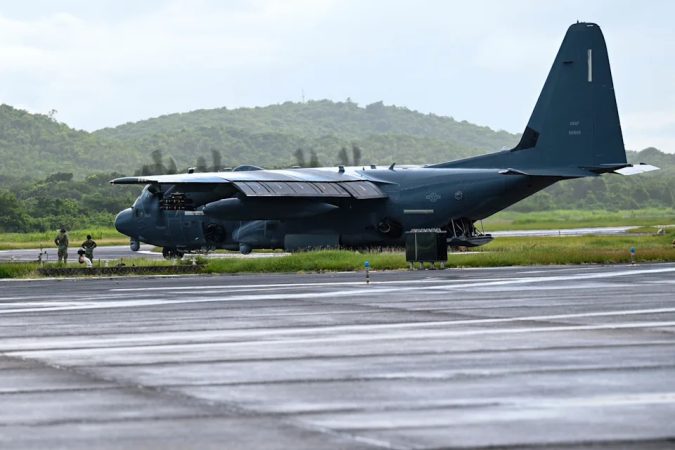
Air Forces Southern, which oversees forces in the region, released photos of Airmen building a munitions armory and repairing a runway in Ceiba, Puerto Rico, where the AC-130s are known to operate.
In addition to the Marine Corps F-35Bs stationed on land, USMC AV-8 Harrier fighter jets and AH-1 attack helicopters are embarked on the USS Iwo Jima, an amphibious assault ship which has been operating in the region, along with a number of destroyers and the Special Operations ship MV Ocean Trader. The Harriers and helicopters have been conducting live-fire exercises in recent weeks.
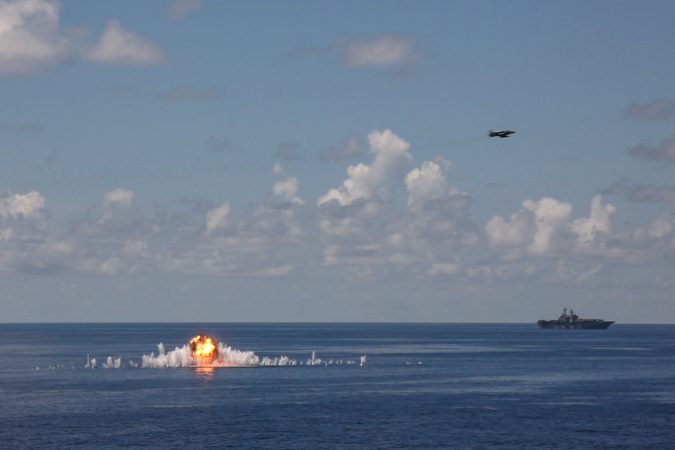
In an Oct. 24 social media announcement of the latest boat strike, Hegseth posted a video of what he said was the first nighttime strike, in which a single munition is seen impacting a small boat in what Hegseth said were international waters. The Pentagon chief said the boat was from the Tren de Argua gang, which the Trump administration has designated a terrorist organization, and the strike killed six people on board, who Hegseth referred to as “narco-terrorists.” At least 43 people have been killed in the U.S. strikes. In the past, the U.S. Coast Guard, sometimes with the assistance of the Navy, has interdicted suspected drug boats.
The Trump administration has said the U.S. is in an “armed conflict” with “unlawful combatants,” claiming the authority to conduct strikes against alleged drug smuggling efforts. While the U.S. has said drug smugglers are its primary priority, the administration is also seeking to pressure Maduro, Venezuela’s authoritarian ruler, from power. Maduro has been charged in the United States for being involved in a conspiracy to smuggle cocaine and guns into the U.S., and the Trump administration is offering $50 million for information that leads to his arrest.
Hegseth compared the latest strikes to those the U.S. has conducted in the Middle East against al-Qaeda and other terrorists. But the boat strikes had not been authorized by Congress and some lawmakers and former Pentagon officials have argued the attacks are not legal.
The U.S. has not presented evidence that the boats are carrying drugs. Two survivors of an Oct. 16 strike were briefly held aboard a U.S. Navy ship, as the U.S. elected not to hold them as prisoners of war or charge them with a crime, and instead said it was sending them to their home countries of Ecuador and Colombia.
“If you are a narco-terrorist smuggling drugs in our hemisphere, we will treat you like we treat Al-Qaeda. Day or NIGHT, we will map your networks, track your people, hunt you down, and kill you,” Hegseth wrote Oct. 24.
